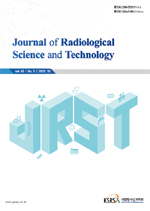YOLO 기반 객체 탐지 기술을 활용한 방사선 모의치료 시 고정기구 사전 인식 시스템 개발
Development of a YOLO-based Object Detection System for Prior Identification of Immobilization Devices in Radiation Therapy Simulation
- 대한방사선과학회(구 대한방사선기술학회)
- 방사선기술과학
- 제48권 제3호
-
2025.06279 - 291 (13 pages)
-
DOI : 10.17946/JRST.2025.48.3.279
- 9

본 연구는 방사선 모의치료 시 환자 고정기구 사전정보의 누락 방지와 업무 효율성을 향상하기 위해 욜로(You Only Look Once, YOLO) 기반 객체 탐지 기술 및 자동 인식 프로그램을 개발하고자 하였다. 프로그램은 파이썬(Python-3.8.19) 기반 PyQt5 GUI 프레임워크로 구성했다. 총 11가지 고정기구를 선정하고, 세 가지 모델(YOLOv11n, YOLOv11s, YOLOv11m)에 대 한 데이터셋 이미지 총 146장을 사용해 데이터 추론을 수행했다. 모델별 성능은 정밀도(Precision), 재현율(Recall), 평균 정확 도인 mAP50 (mean average precision at 50 IoU)와 mAP50—95 (mean average precision at 50:95)로 평가하였다. 평균 정밀 도는 YOLOv11s 모델이 YOLOv11n과 YOLOv11m 모델보다 각각 14.66%, 25.86% 높았다. 평균 재현율은 YOLOv11n 모델이 YOLOv11s와 YOLOv11m 모델보다 각각 18.43%, 0.92% 높았다. mAP50은 모델별 큰 차이가 없었고, mAP50—95 평가에서 YOLOv11n 모델이 YOLOv11s와 YOLOv11m 모델보다 각각 0.46%, 1.28% 높았다. 전반적으로 YOLOv11n 모델이 재현율과 평균 정밀도(mAP50, mAP50—95)에서 가장 높았고, YOLOv11s 모델은 정밀도 평가에서 가장 높았다. YOLOv11m 모델은 정 밀도와 평균 정밀도(mAP) 평가에서 다른 모델에 비해 낮았다. 본 연구는 욜로 기반 객체 탐지 기술이 방사선 모의치료 시 고 정기구 사전정보의 누락을 방지하고 환자 안전을 향상할 것으로 기대된다. 향후 다양한 고정기구와 환자 자세 유형을 포함한 추가 데이터 학습 및 모델 최적화 연구를 통해 임상 적용 가능성을 높일 필요가 있다.
This study aimed to develop an object detection and automatic recognition system based on YOLO (You Only Look Once) to enable the prior identification of immobilization devices and enhance workflow efficiency during radiation therapy simulation. The system was implemented using the PyQt5 GUI framework in Python (version 3.8.19). A total of 11 types of immobilization devices were selected, and inference was conducted using 146 dataset images across three YOLOv11 model variants (YOLOv11n, YOLOv11s, YOLOv11m). Model performance was evaluated using precision, recall, and mean average precision at IoU thresholds of 0.5 (mAP50) and 0.50—0.95 (mAP50—95). The YOLOv11s model showed the highest precision, outperforming YOLOv11n and YOLOv11m by 14.66% and 25.86%, respectively. In contrast, the YOLOv11n model demon- strated the highest recall, surpassing YOLOv11s and YOLOv11m by 18.43% and 0.92%, respectively. While mAP50 values were similar across models, YOLOv11n achieved slightly higher mAP50—95 values than YOLOv11s and YOLOv11m by 0.46% and 1.28%, respectively. Overall, YOLOv11n exhibited superior performance in terms of recall, mAP50, and mAP50—95, whereas YOLOv11s excelled in precision. YOLOv11m showed relatively lower performance across most metrics. These findings suggest that YOLO-based object detection technology may enhance patient safety by facilitating the prior identification of immobilization device during radiation therapy simulation. Future studies incorporating various device types, patient positioning variations, and model optimization are needed to improve clinical applicability.
Ⅰ. 서 론
Ⅱ. 대상 및 방법
Ⅲ. 결 과
Ⅳ. 고 찰
Ⅴ. 결 론
REFERENCES
(0)
(0)